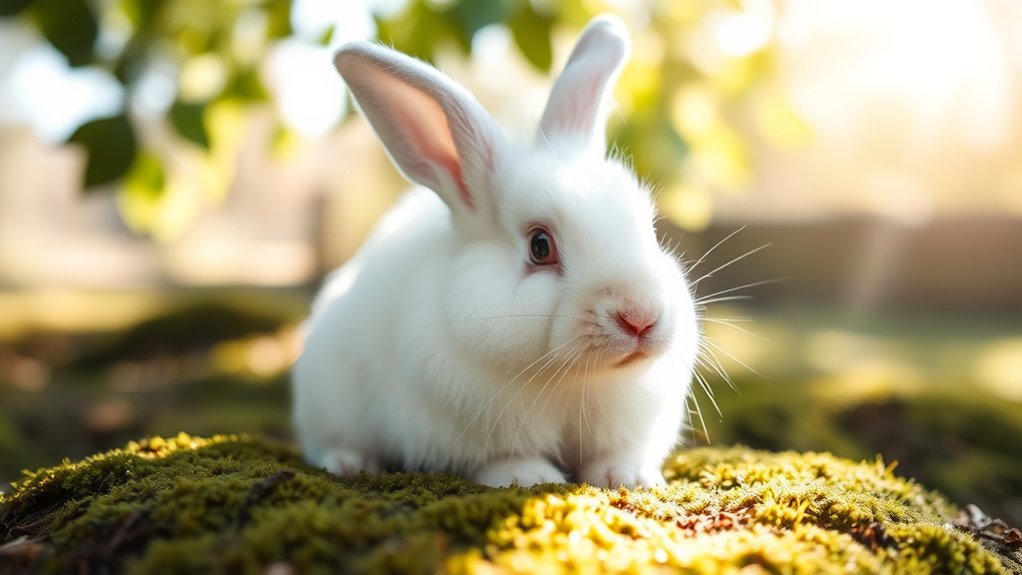To understand rabbit body language, pay attention to their posture and movements. Relaxed rabbits lie stretched out, with soft eyes and upright or slightly tilted ears. When scared, they might tremble, cower, or avoid eye contact. Playful rabbits hop, flick their tails, or wiggle their noses. Recognizing these cues helps you better interpret their feelings and respond appropriately, making interactions safer and more comfortable — keep exploring to learn more about your rabbit’s signals.
Key Takeaways
- Relaxed rabbits lie stretched out or sit comfortably, with soft eyes and ears upright or gently tilted.
- Signs of fear include trembling, flattened ears, tense body, and darting or avoiding eye contact.
- Aggressive signals such as growling, teeth chattering, or lunging indicate the rabbit feels threatened.
- Playful behavior, like tail flicks or hopping, shows happiness and curiosity.
- Grooming, lying flat, or stretching suggests the rabbit feels relaxed and secure in its environment.
Recognizing Relaxed and Happy Postures
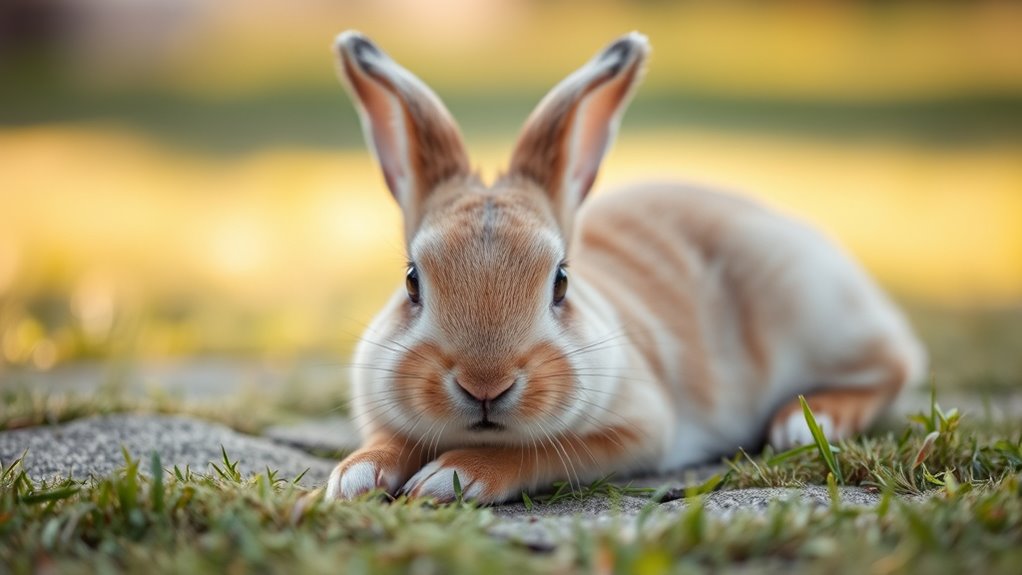
When a rabbit is genuinely relaxed and happy, it displays clear body language cues that you can easily recognize. Bunny communication relies heavily on these signals to show contentment. You might notice your rabbit lying stretched out on its side or tummy, which indicates comfort. A relaxed rabbit often lounges with its paws tucked in or sprawled out, showing trust in its environment. Its ears may be upright or slightly tilted, not tense or pinned back. You’ll see a gentle, soft gaze, and sometimes a little nose twitching. These body language cues signal that your rabbit feels safe and at ease. Recognizing these signs helps you understand your pet’s emotional state and reinforces a positive bond. Understanding rabbit body language is essential for ensuring your bunny’s well-being and happiness.
Identifying Signs of Fear or Stress
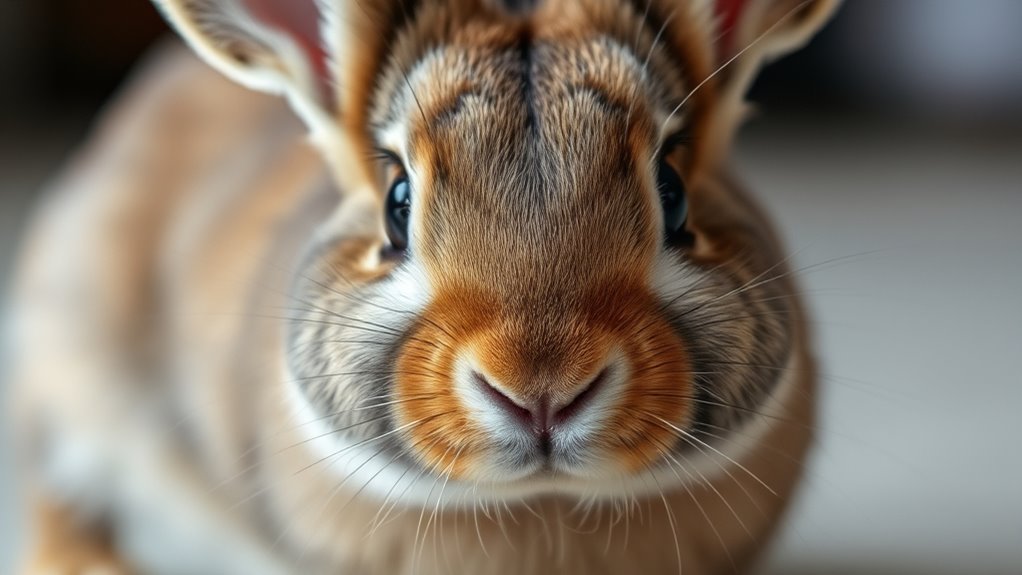
If your rabbit feels threatened or overwhelmed, it will often display clear signs of fear or stress. You might notice unusual bunny vocalizations, such as high-pitched squeals or growls, signaling discomfort. Additionally, stress can cause changes in chewing habits; your rabbit might chew rapidly or excessively on nearby objects, possibly as a way to cope. You may also see trembling or a tense body posture, with ears flat against the back and a hunched stance. Avoiding eye contact or suddenly darting away are also common stress signals. Recognizing these signs early helps you respond calmly, reducing your rabbit’s anxiety and preventing escalation. Paying close attention to these cues guarantees you can create a more secure environment for your bunny. Understanding body language is crucial for interpreting your rabbit’s emotional state accurately.
Understanding Aggressive and Defensive Gestures
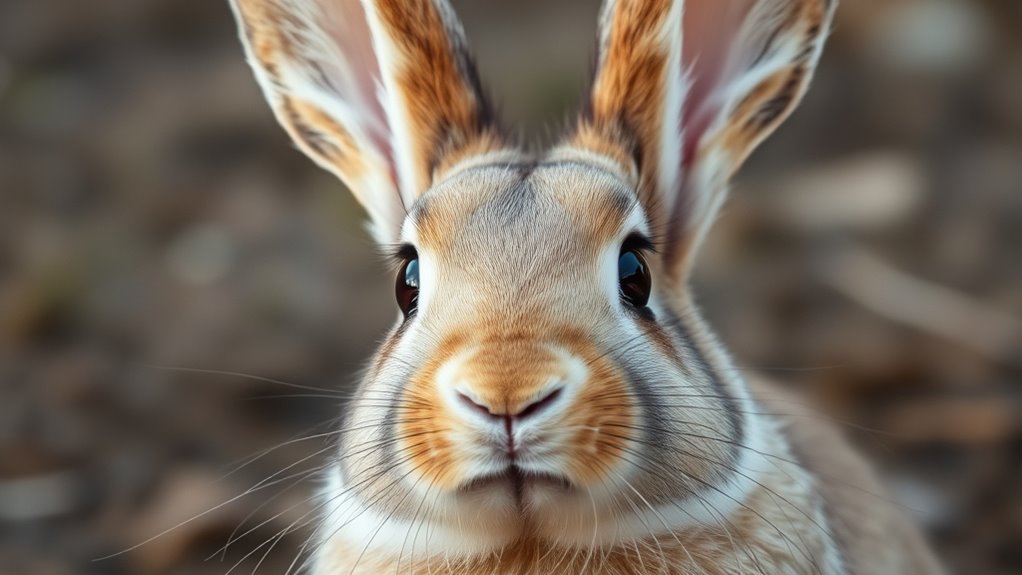
Recognizing aggressive and defensive gestures in your rabbit is essential for maintaining a safe and respectful relationship. Bunny social cues like growling, teeth chattering, or stiff body language often signal your rabbit feels threatened. Aggressive posturing might include lunging, raised fur, or a direct stare, indicating they want to defend themselves or establish dominance. Defensive gestures can also involve thumping a hind leg loudly or freezing in place, showing they’re feeling cornered or unsure. By understanding these signals, you can prevent escalation and give your rabbit space to calm down. Respond calmly and avoid sudden movements. Remember, these behaviors are your rabbit’s way of communicating discomfort or fear, and respecting their signals helps build trust and keeps interactions safe. Additionally, color accuracy plays a vital role in how your rabbit perceives your environment, which can influence their behavior and stress levels.
Reading Playful and Curious Movements
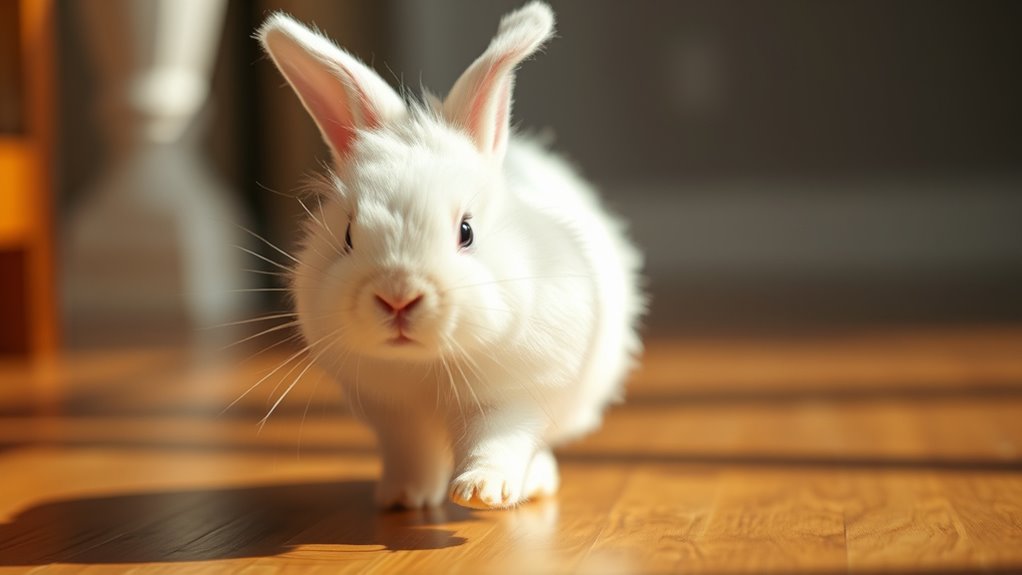
Playful and curious movements reveal a rabbit’s happy and relaxed state, providing insight into their comfort level. When your rabbit is feeling playful, you might notice tail flicks—quick, gentle swishes of the tail that signal excitement or interest. Nose wiggles are another sign of curiosity; your rabbit might wiggle or twitch their nose as they explore their surroundings or investigate new objects. These behaviors show that your rabbit is engaged and comfortable, not stressed. You may also see them hop around energetically, binky (a joyful leap and twist), or spin in circles. Together, tail flicks and nose wiggles serve as clear indicators that your rabbit is feeling playful and enthusiastic to interact. Recognizing these movements helps you understand when your rabbit is happy and curious. Understanding rabbit body language enhances your ability to interpret their emotional state and respond appropriately.
Interpreting Grooming and Resting Behaviors
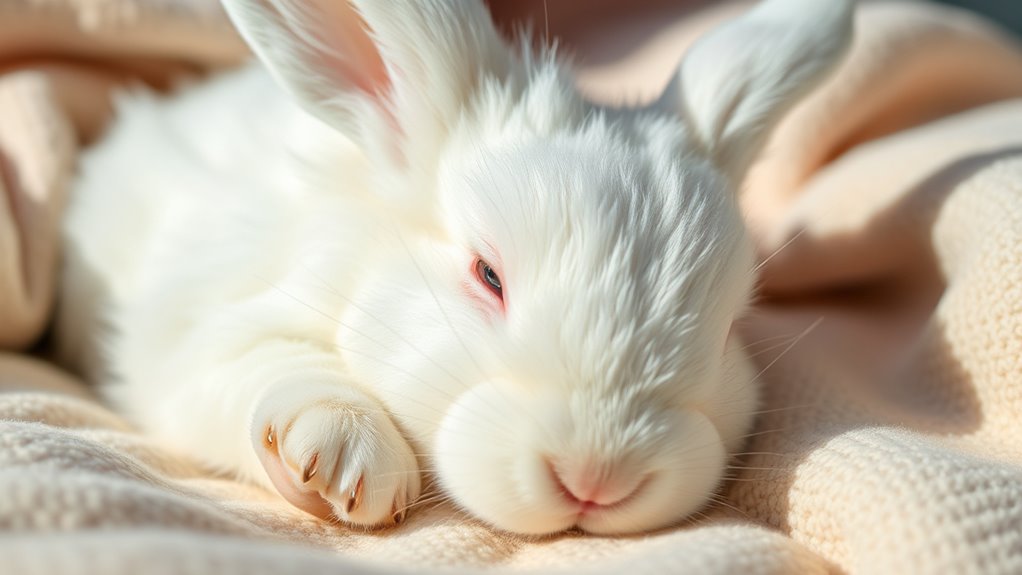
Grooming and resting behaviors are key indicators of your rabbit’s well-being and comfort. When your rabbit grooms itself, it’s a grooming signal that they feel safe and relaxed. Conversely, excessive grooming may suggest stress or discomfort. Resting postures also reveal their mood; a stretched-out rabbit indicates relaxation, while a tucked-in position shows they’re feeling cautious. Use the table below to understand these behaviors better:
| Behavior | Meaning |
|---|---|
| Grooming frequently | Feeling relaxed or comforting itself |
| Lying flat | Deep relaxation and trust |
| Sitting upright | Alert but comfortable |
| Tucked-in posture | Feeling nervous or cold |
| Stretching out | Content and at ease |
Observe these signs to gauge your rabbit’s emotional state and ensure they’re comfortable. Recognizing rabbit body language can help you better understand their needs and foster a trusting relationship.
Frequently Asked Questions
How Can I Differentiate Between a Rabbit’S Sleep and Illness?
To tell if your rabbit is sleeping or ill, observe their behavior closely. Signs of fatigue include relaxed posture and slow breathing, while signs of discomfort may involve lethargy, decreased appetite, or unusual hiding. If your rabbit stays inactive longer than usual or shows signs of distress, it’s best to consult a vet. Always monitor their daily habits to catch changes early and guarantee they’re healthy and well-rested.
What Does It Mean if My Rabbit Thumps Loudly?
Thumping loudly might seem like just a noise, but it carries significant meaning. Its thumping significance often signals a warning, alerting you to danger or something unusual in their environment. This loud thump is a warning signal, a way for your rabbit to communicate concern or fear. Recognizing this behavior helps you respond promptly, ensuring your rabbit feels safe and understood, and avoids potential stress or harm.
How Do Age and Breed Influence Rabbit Body Language?
Age and breed greatly influence how your rabbit expresses itself. Age-related behaviors, like increased curiosity or sluggishness, shape their body language, while breed-specific signals, such as the alert stance of a Dutch or the relaxed posture of a lop, help you interpret their mood. Recognizing these differences allows you to better understand your rabbit’s needs and feelings, strengthening your bond and ensuring their well-being.
Can Rabbits Communicate Their Preferences Through Body Posture?
While rabbits can’t speak, their body posture cues reveal their preferences signals clearly. You’ll notice relaxed stretches or leaning in when they’re comfortable, versus tense or hunched postures indicating discomfort. Their body language acts as a silent conversation, showing what they prefer or dislike. Paying attention to these cues helps you understand their feelings, making your bond stronger and ensuring they feel safe and respected in your care.
How Does Environmental Change Affect My Rabbit’S Behavior Signals?
Environmental change can profoundly impact your rabbit’s behavior signals. When faced with environmental stress or habitat modifications, your rabbit might display signs like increased hiding, reduced activity, or aggressive body language. These behaviors are your rabbit’s way of coping with unfamiliar surroundings or disruptions. To help, keep their environment consistent and gradually introduce any changes, so they feel safe and secure, minimizing stress and encouraging positive behavior signals.
Conclusion
Now that you’ve started to understand your rabbit’s body language, you’re closer to building a stronger bond. But remember, their signals can change quickly, revealing surprises you might not expect. Stay attentive and keep observing—your rabbit’s next move could tell you even more. With each new gesture, you uncover secrets that deepen your connection. Are you ready to discover what your bunny’s next body language might reveal? The journey has only just begun.
